Removal Procedure
Tools Required
J 41427 Engine Lift
Bracket

- Remove the radiator support.
Refer to
Radiator Support Replacement
in Body Front End.
- Remove the engine cover. Refer to
Engine Cover Replacement
in Interior Trim.
- Remove the engine cooling fan. Refer to
Fan Clutch Replacement
in Engine Cooling.
- Remove the stud and bolt holding the ground wires to the rear
of both cylinder heads.
- Disconnect the following electrical connections:
| • | The fuel meter body assembly |
| • | The EVAP canister purge solenoid valve |
| • | The idle air control (IAC) motor |
| • | The throttle position (TP) sensor |
| • | The manifold absolute pressure (MAP) |
| • | The A/C compressor high pressure switch, if equipped |
| • | The A/C clutch switch, if equipped |
| • | The exhaust gas recirculation (EGR) valve |
| • | The engine coolant temperature (ECT) sensor |
| • | The ignition control module (ICM) |
| • | The generator positive cable and connector |
| • | The crankcase position (CKP) sensor |
| • | The engine oil pressure (OP) gauge sensor |
- Remove the nut holding the ground wire to the water outlet stud.
- Remove the nut holding the wiring harness at the transmission
to engine stud.
- Remove the engine wiring harness from the stud on the generator
mounting bracket.
- Move the engine wiring harness aside.

- Remove the bolt holding
the battery negative cable and the ground strap to the front of the engine.
- Remove the generator mounting bracket. Refer to
Accessory Mounting Brackets Replacement
.
- Remove the heater hoses from the engine . Refer to
Heater Hoses Replacement
in Heating and Ventilation
(Non-A/C).
- Remove the radiator inlet and outlet hoses. Refer to
Radiator Hose Replacement
in Engine Cooling.
- Remove the A/C compressor pipes from the vehicle. Refer to
Compressor Hose Assembly Replacement
in HVAC Systems
with A/C - Manual.
- Remove the power steering pump mounting bracket. Refer to
Accessory Mounting Brackets Replacement
.
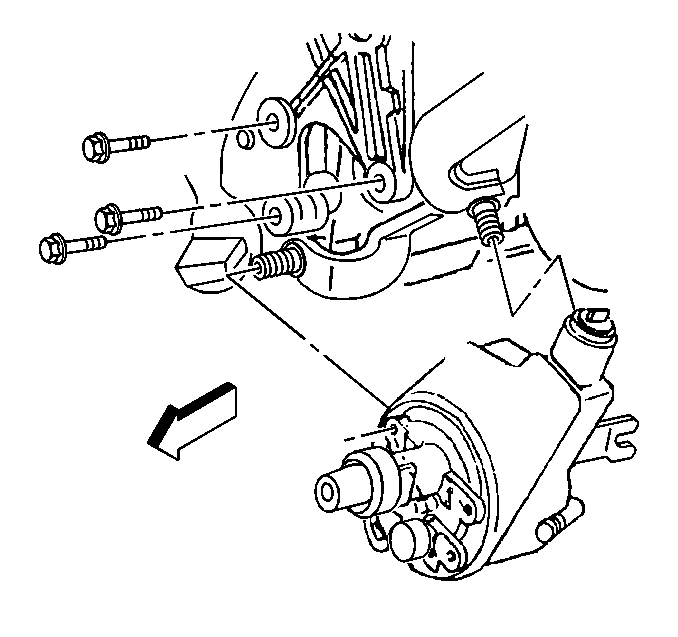
- Remove the power steering
pump rear mounting bracket from the engine. Set the pump aside.
Caution: In order to avoid possible injury or vehicle damage, always replace
the accelerator control cable with a NEW cable whenever you remove the engine
from the vehicle.
In order to avoid cruise control cable damage, position the cable out
of the way while you remove or install the engine. Do not pry
or lean against the cruise control cable and do not kink the cable. You must
replace a damaged cable.
- Remove the accelerator control cable from the throttle shaft. Refer
to
Accelerator Control Cable Replacement
in Engine Controls.
- Remove the cruise control cable, if equipped from the throttle
shaft. Refer to
Cruise Control Cable Replacement
in Cruise Control.
- Remove the distributor. Refer to
Distributor Replacement
in Engine Electrical.
- In order to allow access for the lifting device, remove the upper
intake manifold. Refer to
Intake Manifold Replacement
.
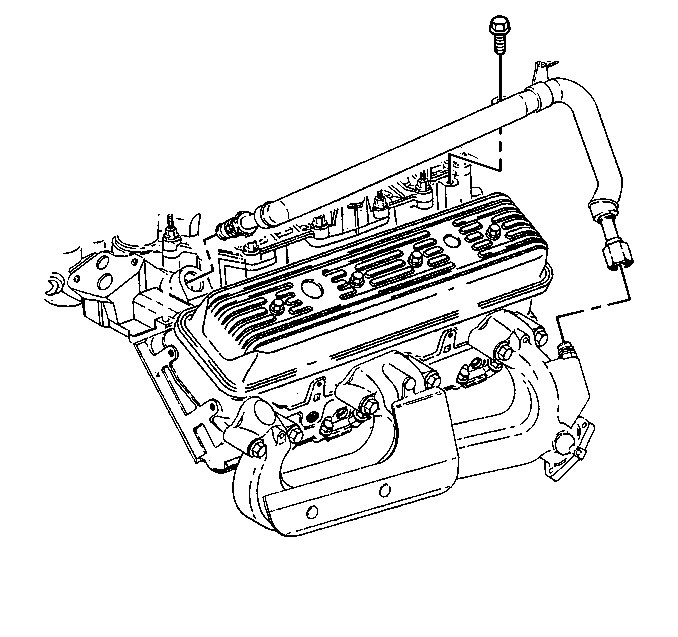
- Remove the EGR valve inlet
pipe from the intake and exhaust manifold.
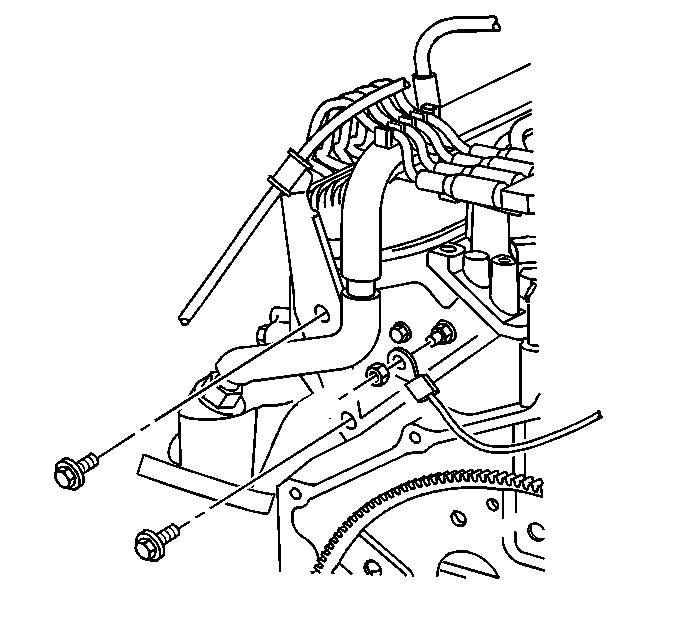
- Remove the transmission
control cable bracket from the rear of the left cylinder head.
- Raise the vehicle and support with safety stands. Refer to
Lifting and Jacking the Vehicle
in General Information.
- Remove both exhaust manifolds. Refer to
Exhaust Manifold Replacement
.
- Remove the oil pan drain plug and drain the engine oil into a
suitable container.
- Remove the engine oil filter.
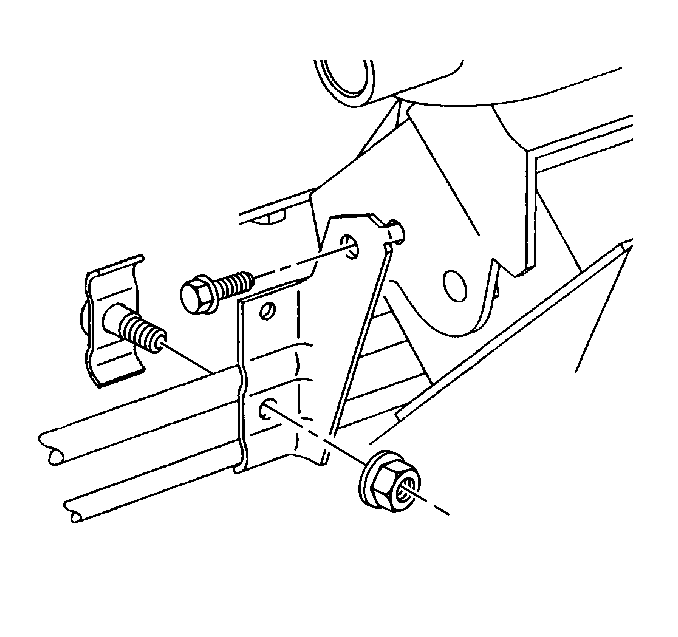
- Remove the engine oil
cooler pipes from the retaining brackets.
- Remove the engine oil cooler pipes from the engine. Refer to
Engine Oil Cooler Hose/Pipe Replacement
in Engine
Cooling.
- Remove the starter motor. Refer to
Starter Motor Replacement
in Engine Electrical.
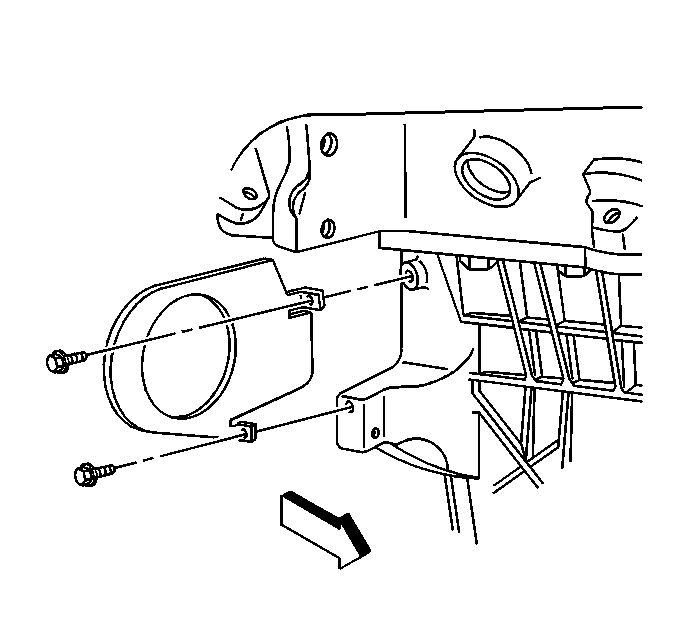
- Remove the transmission
cover.
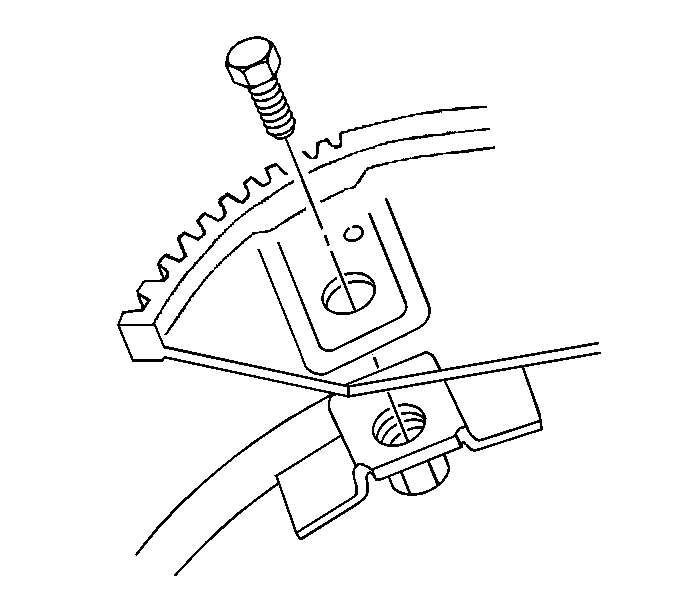
- Remove the torque converter
bolts from the flywheel through the transmission cover opening.

- Remove the transmission
cooler pipes from the engine.
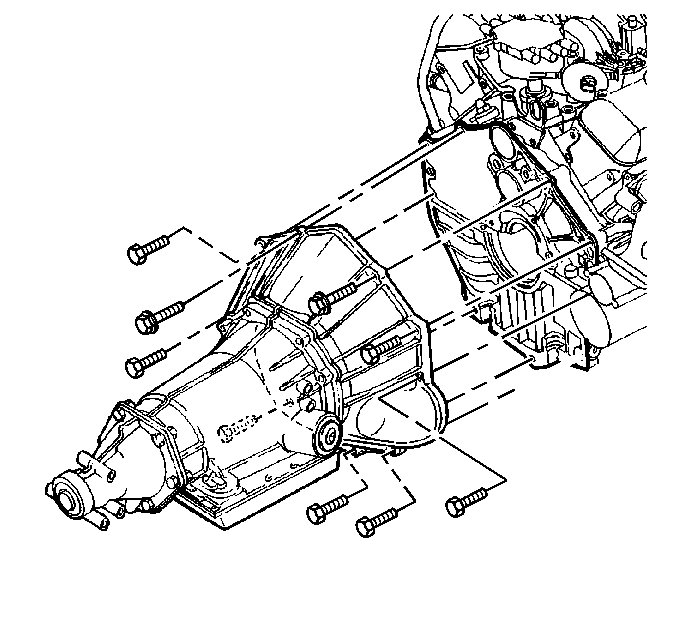
- Remove the bolts holding
the transmission to the engine except the top two bolts.
- Remove the safety stands and lower the vehicle.
- Support the transmission with a strap between the frame rails
or use a suitable transmission jack.
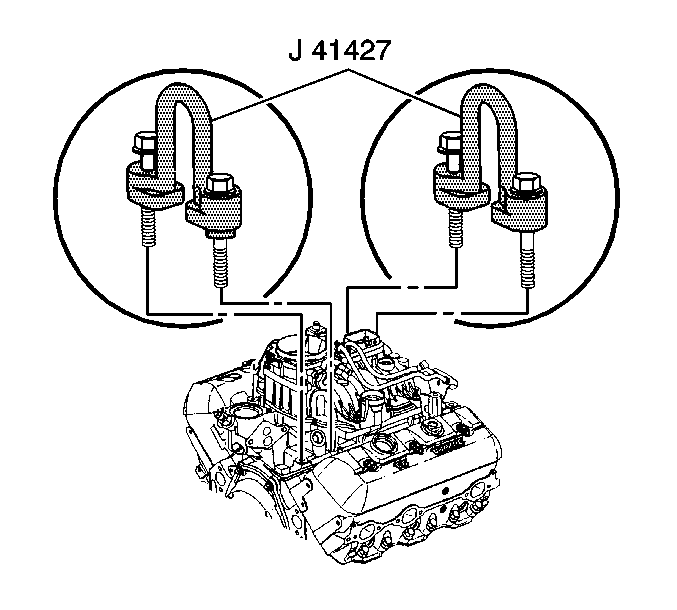
- Install the J 41427
using the following procedure:
| 36.1. | Remove the two right rear lower intake manifold bolts. |
| 36.2. | Install the J 41427
marked RIGHT REAR. |
Notice: Use the correct fastener in the correct location. Replacement fasteners
must be the correct part number for that application. Fasteners requiring
replacement or fasteners requiring the use of thread locking compound or sealant
are identified in the service procedure. Do not use paints, lubricants, or
corrosion inhibitors on fasteners or fastener joint surfaces unless specified.
These coatings affect fastener torque and joint clamping force and may damage
the fastener. Use the correct tightening sequence and specifications when
installing fasteners in order to avoid damage to parts and systems.
| 36.3. | Install the retaining
bolts. |
Tighten
Tighten the retaining bolts to 15 N·m (11 lb ft).
| 36.4. | Remove the two left front lower intake manifold bolts. |
| 36.5. | Install the J 41427
marked LEFT FRONT with the arrow pointing to the front of the engine. |
| 36.6. | Install the retaining bolts. |
Tighten
Tighten the retaining bolts to 15 N·m (11 lb ft).
- Attach a suitable engine lifting device to the J 41427
.
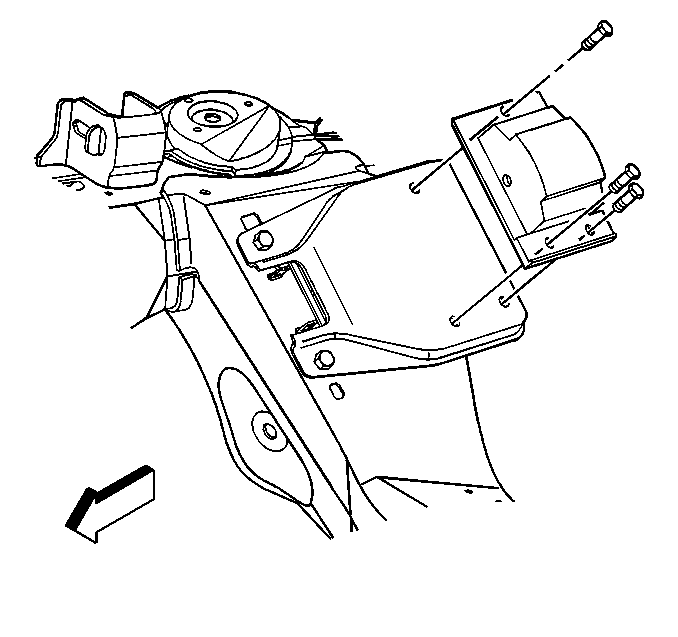
- Remove the engine mounts
from the engine mount frame brackets. Refer to
Engine Mount Replacement
.
- Remove the two remaining engine to transmission bolts.
- Remove the engine assembly from the vehicle.
Installation Procedure
Tools Required
J 41427 Engine Lift
Brackets
- Install the engine assembly to the vehicle.
- Loosely install the two upper transmission to engine bolts.

- Install the engine mounts
to the engine mount frame brackets. Refer to
Engine Mount Replacement
.
- Remove the engine lifting device.

- Remove the J 41427
from the engine.
- Apply thread lock GM PN 12345382 or equivalent to
the threads of the lower intake manifold bolts.
- Install the lower intake manifold bolts.
Tighten
- Tighten the bolts the first pass to 3 N·m (27 lb in).
- Tighten the bolts the second pass to 12 N·m (106 lb in).
- Tighten the bolts the third pass to 15 N·m (11 lb ft).
- Raise the vehicle and support with safety stands. Refer to
Lifting and Jacking the Vehicle
in General Information.
- Install the remaining bolts from the transmission to the engine.
Refer to
Transmission Replacement
in
Automatic Transmission for location of the proper bolts and tightening
specifications.

Notice: Use the correct fastener in the correct location. Replacement fasteners
must be the correct part number for that application. Fasteners requiring
replacement or fasteners requiring the use of thread locking compound or sealant
are identified in the service procedure. Do not use paints, lubricants, or
corrosion inhibitors on fasteners or fastener joint surfaces unless specified.
These coatings affect fastener torque and joint clamping force and may damage
the fastener. Use the correct tightening sequence and specifications when
installing fasteners in order to avoid damage to parts and systems.
- Install the bolt
holding the transmission cooler pipes bracket to the oil pan.
Tighten
Tighten the bolt to 12 N·m (106 lb in).
- Install the torque converter bolts to the flywheel. Refer to
Transmission Replacement
in Automatic Transmission.

- Install the transmission
cover.
Tighten
Tighten the transmission cover bolts to 12 N·m (106 lb in).
- Install the starter motor. Refer to
Starter Motor Replacement
in Engine Electrical.
- Install the engine oil cooler pipes to the engine. Refer to
Engine Oil Cooler Hose/Pipe Replacement
in Engine
Cooling.

- Install the engine oil
cooler pipes to the retaining brackets.
- Install the exhaust manifolds. Refer to
Exhaust Manifold Replacement
.
- Remove the safety stands and lower the vehicle.

- Install the transmission
control cable bracket to the rear of the left cylinder head.
Tighten
Tighten the transmission control cable bracket bolts to 40 N·m
(30 lb ft).
- Install the upper intake manifold to the engine. Refer to
Intake Manifold Replacement
.

- Install the EGR valve
inlet pipe to the intake and the exhaust manifolds.
Tighten
| • | Tighten the EGR valve inlet pipe intake nut to 25 N·m
(18 lb ft). |
| • | Tighten the EGR valve inlet pipe exhaust nut to 30 N·m
(22 ft). |
| • | Tighten the EGR valve inlet pipe clamp bolt to 25 N·m
(18 lb ft). |
- Install the distributor. Refer to
Distributor Replacement
in Engine Electrical.
Caution: In order to avoid possible injury or vehicle damage, always replace
the accelerator control cable with a NEW cable whenever you remove the engine
from the vehicle.
In order to avoid cruise control cable damage, position the cable out
of the way while you remove or install the engine. Do not pry
or lean against the cruise control cable and do not kink the cable. You must
replace a damaged cable.
- Install a NEW accelerator control cable. Refer to
Accelerator Control Cable Replacement
in Engine Controls.
- Install the cruise control cable, if equipped. Refer to
Cruise Control Cable Replacement
in Cruise Control.
- Install the power steering pump with the rear bracket to the engine.
Refer to
Power Steering Pump Replacement
in Power Steering Systems.
- Install the power steering pump mounting bracket. Refer to
Accessory Mounting Brackets Replacement
.
- Install the A/C compressor pipes to the vehicle. Refer to
Compressor Hose Assembly Replacement
in HVAC Systems
with A/C - Manual.
- Install the radiator inlet and outlet hoses to the engine. Refer
to
Radiator Hose Replacement
in
Engine Cooling.
- Install the heater hoses to the engine. Refer to
Heater Hoses Replacement
in Heating and Ventilation (Non-A/C).
- Install the generator mounting bracket. Refer to
Accessory Mounting Brackets Replacement
.

- Install the bolt holding
the battery negative cable and the ground strap to the front of the engine.
Tighten
Tighten the bolt to 25 N·m (18 lb ft).

- Position the engine wiring
harness.
- Install the engine wiring harness on the stud at the generator
mounting bracket.
- Connect the following electrical connections:
| • | The fuel meter body assembly |
| • | The EVAP canister purge solenoid valve |
| • | The idle air control (IAC) motor |
| • | The throttle position (TP) sensor |
| • | The manifold absolute pressure (MAP) |
| • | The A/C compressor high pressure switch, if equipped |
| • | The A/C clutch switch, if equipped |
| • | The exhaust gas recirculation (EGR) valve |
| • | The engine coolant temperature (ECT) sensor |
| • | The ignition control module (ICM) |
| • | The generator positive cable and connector |
| • | The crankcase position (CKP) sensor |
| • | The engine oil pressure (OP) gauge sensor |
- Install the stud and bolt holding the ground wires to the rear
of both cylinder heads.
Tighten
Tighten the bolt and the stud to 10 N·m (88 lb in).
- Install the nut holding the ground wire to the water outlet stud.
Tighten
Tighten the nut to 10 N·m (88 lb in).
- Install the nut holding the engine wiring harness at the transmission
to engine stud.
Tighten
Tighten the nut to 10 N·m (88 lb in).
- Install the fan clutch to the water pump. Refer to
Fan Clutch Replacement
in Engine Cooling.
- Install the radiator support. Refer to
Radiator Support Replacement
in Body Front End.
- Install the oil filter and fill the engine with engine oil. Refer
to
Engine Oil and Oil Filter Replacement
.
- Fill the cooling system with the proper quantity and type of coolant.
Refer to
Cooling System Draining and Filling
in Engine Cooling.
- Operate the engine and check for proper operation. Refer to Engine Set-Up and Testing
.
- Install the engine cover. Refer to
Engine Cover Replacement
in Interior Trim.





















